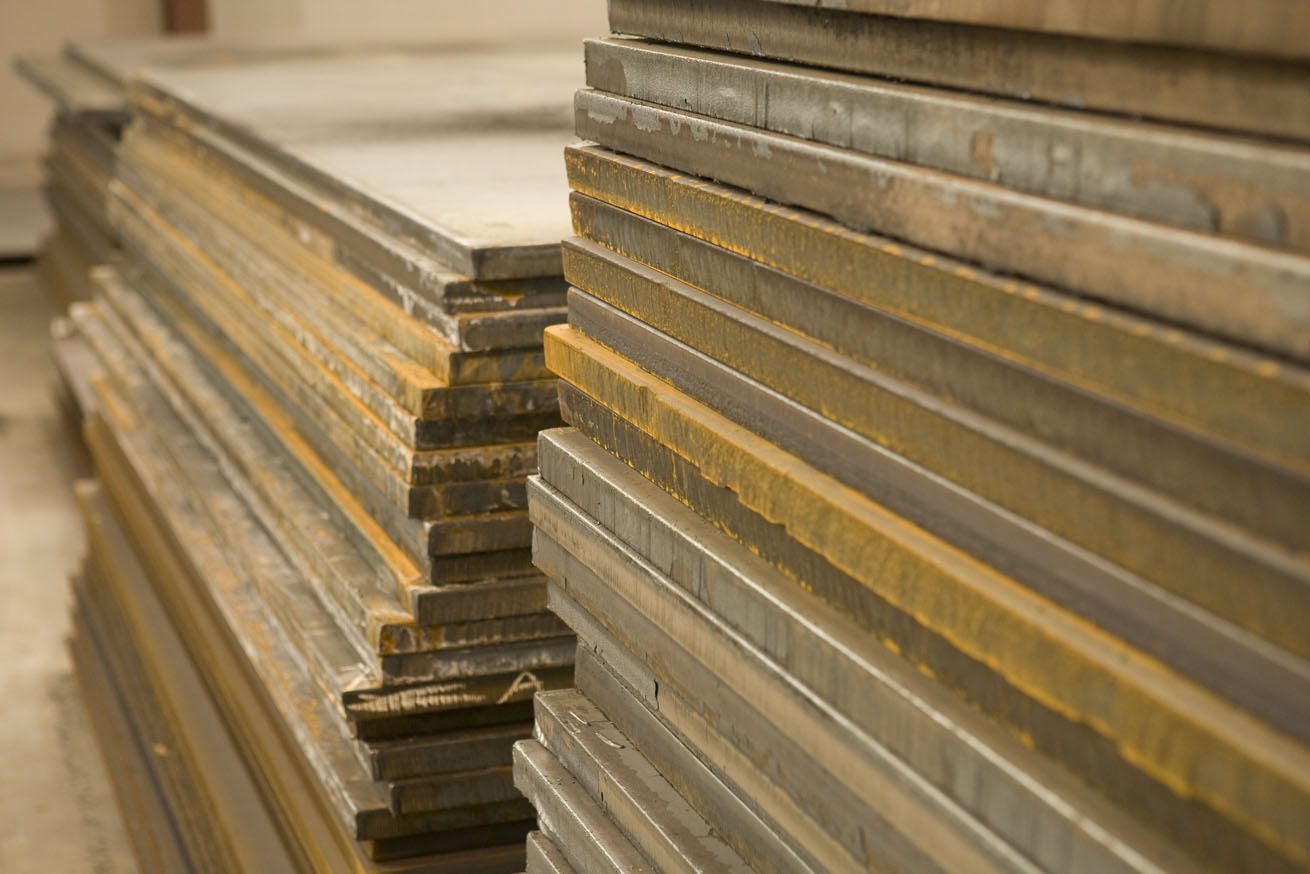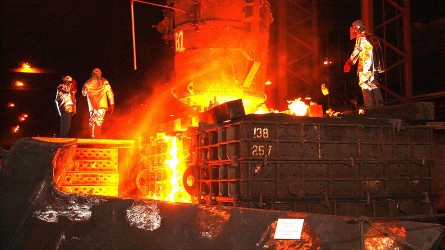We use cookies to analyze traffic and improve your experience. We may also share your information with our analytics partners to improve our website, as detailed in our Privacy Policy. You consent to our cookies if you continue to use this website.

The process of buying steel plate may seem as simple as determining your plate needs and picking up the phone to place an order or buying online, but steel plate’s supply chain is robust and complex. Leeco® Steel sees many customers with complex needs and works with them to successfully navigate the steel plate supply chain.
From production to delivery to methods of ordering, here is what you need to know about the steel plate supply chain and consider when you place a plate order.

Lead time plays an important role in the steel plate supply chain, as production requires many resources – raw goods, equipment capacity, workers – and time.
Mills plan their production schedules – or “books” – months in advance and determine lead time after an order is placed. Leeco closely works with mills and keeps customers updated about lead times.
Mills usually require at least a month lead time on a steel plate order. Depending on the size and complexity of the order, lead times can be longer. External factors such as bad weather, equipment failure, equipment maintenance and holidays can also impact lead times. It is important for buyers to consider factors that can and cannot be planned for when placing an order to ensure their plate will arrive on-time.
Lead times can also vary depending on the type of mill. There are two mill types: integrated and mini. Integrated mills produce steel from raw materials and have a longer production process than mini mills, meaning a plate order would require more lead time. Leeco sources steel plate from both integrated mills and mini mills.
Making steel plate is a complex process requiring a great deal of resources and time. For this reason, production lead time and the factors impacting it are important for steel plate buyers to understand. This section looks at mill production and how production processes impact overall lead time.

Integrated mills produce steel using raw materials such as iron ore, coke – produced from coal – and limestone. To produce coke, coal is crushed, ground into a powder and heated in an oven. After the coke is cooled, it is reduced, or smelted with iron ore and limestone in a blast furnace, or basic oxygen furnace. The molten iron is then either cast into pig iron or moves to the next stage of production.
Integrated mills first began producing steel hundreds of years ago and continue to remain the most common type of mill worldwide, producing about three-quarters of the world’s steel. Due to the recent growth of mini mills in the U.S., integrated mills currently produce about one-third of U.S.-made steel, according to the World Steel Association.
The process of making coke can take anywhere from 18-24 hours. While furnaces at integrated mills traditionally took hours to make steel after coke production, modern basic oxygen furnaces can convert raw materials to molten steel in about 45 minutes.
Mini mills, on the other hand, produce steel using recycled scrap steel and metals instead of raw natural resources. Mini mills melt the scrap metals with pig iron in an electric arc furnace, purify the molten steel, then pour it into a slab.
Using recycled scrap metals is a newer method of producing steel and accounts for about one-quarter of the world’s steel production. With recent improvements to the process of sorting usable scrap and the quality of steel made from scrap, mini mills quickly grew in the U.S. and currently produce about two-thirds of U.S.-made steel.
Electric arc furnaces can typically produce molten steel from scrap metals in about 40 minutes. Before modernizations of blast oxygen furnaces, electric arc furnace production was historically much faster and less resource intensive.
After plate is formed and cooled, it can either be heat treated or supplied in the as-rolled condition. Heat treatments – such as normalizing and quenching and tempering – are used to increase strength, hardness and ductility of plate. These treatments are used for certain plate grades, such as AR500, and applications where strength and hardness are important.
Heat-treatments involve re-heating and re-cooling steel plate. These additional steps can take several hours and increase production lead time compared to the lead time of as-rolled plate.
After mills finish producing steel plate, the plate is then transported to the next destination in its supply chain journey.
The transportation mode used to ship plate depends on a variety of factors, such as location and weight. Rail, truck and barge are the most common ways steel plate is transported. Steel plate can also be transported using any combination of these three, known as intermodal transportation. Some steel plate suppliers, like Leeco, provide freight for their customers – if a supplier does not provide transit, buyers are responsible for coordinating their own plate delivery.
|
Mode |
Container Capacity |
Travel Time |
Cost |
| Rail |
90 tons |
10-14 days |
$$ |
| Truck |
21 tons |
1-7 days |
$$$ |
| Barge |
1,500 tons |
10-30 days |
$ |
Rail is used to ship steel plate over longer distances and is the typical shipping method from mills. On average, rail transit takes about 10-14 days to deliver steel plate to its destination but can experience delays due to weather and maintenance.
Railcars have a significantly higher carrying capacity than trucks, with some able to carry up to 90 tons (180,000 lbs), or about four full truckloads, of steel plate. If a steel plate buyer, for example, orders standard-sized 0.5in x 8ft x 20ft steel plate, they can ship about 51 standard-sized plates per railcar.
One of the limitations of rail transit is that it can only deliver to locations with a rail line. Since many manufacturers may not have a line direct to their production facility, rail-only transit may not be feasible for some buyers.
Trucks are typically the fastest means of transporting steel plate and can deliver to nearly any location. Depending on the proximity of a warehouse or storage facility to a buyer, a plate order could be delivered within a day, but most likely takes between 2-7 days.
Trucks have smaller carrying capacities and can transport anywhere from less-than-truckload to a full truckload of steel plate. A full truckload can carry about 21 tons (42,000 lbs) of plate. Using our steel plate buyer example from above, the buyer can ship a maximum of 12 plates on a truck.
The cost associated with truck shipping depends on the distance traveled, but trucks tend to be faster and more cost-effective for shorter distance deliveries.
Large barges are used to transport plate products over bodies of water, including via domestic waterways. Out of the three steel transport modes, barges take the longest time – it can take a cargo ship 15-30 days to cross the Pacific Ocean and 10-20 days to cross the Atlantic Ocean.
Like railcars, cargo shipping containers have a high capacity. The largest standard shipping container can carry about 29 tons (58,930 lbs) of plate. Barges themselves can carry thousands of shipping containers, meaning one ship could contain thousands of tons of steel.
Barges can be a cost-effective shipping method for both domestic and international deliveries, depending on the destination’s proximity to major waterways and ports. Barges are also the only effective shipping method for transcontinental deliveries between Asia, Europe and North and South America.
Sometimes, freight methods need to be combined to get steel plate to its final destination. For example, some destinations may not be accessible by rail, and a truck may be necessary to transport plate at some point in the shipping process.
If steel is sourced internationally, it will also likely need to be transported via truck or rail from a port to its destination.
In these scenarios, intermodal shipping is necessary to transport plate, however, some businesses may use intermodal shipping even if it is not absolutely necessary if it is more time or cost-effective.
After taking lead times and transportation into consideration, buyers will also need to determine which steel plate buying option best suits their material needs and purchasing process.
Steel plate orders have traditionally been placed and quoted via phone or over email with a sales representative. However, with the increasing digitization of the steel industry, some steel plate suppliers – like Leeco – provide the option for customers to buy steel plate online.
Depending on your order requirements, one buying method may be better aligned to your order requirements than another.
For example, if you are looking to purchase commonly-used steel plate grades, such as ASTM A572 or AR500, in standard sizes, buying online may be a quicker option. Ecommerce websites typically offer extensive stock of these grades, allowing steel plate buyers to quickly receive a quote and place an order at any time.
If your steel plate needs are more complex, however – such as requiring a specialty grade, non-standard sizes or extensive processing – placing an order through a sales representative at your supplier of choice allows for more order customization and may be more suitable for your supply chain than ordering through a website.
At Leeco Steel, we offer both buying options for our customers via our expert sales team and our Leeco Pro ecommerce website. This gives buyers greater control and flexibility of their sourcing process.
Navigating the steel plate supply chain can be difficult – lead times and transportation play key roles in determining how long it takes you to get the plate you need. When choosing a source for your steel plate, it is important to consider these factors in your supplier:
These are just some of the factors to consider. For more consideration, check out our guide to buying steel plate.
With 11 strategically located distribution centers across North America and a wide inventory of steel plate products, Leeco Steel already has the plate you need in-stock and can get it to you quickly. Contact Leeco Steel to see how discuss your steel plate needs or browse our products and build a quote online.
Looking for a quote? We recommend you use our quote builder or submit a request for quote document via our RFQ Form.
Quote Builder Submit an RFQ